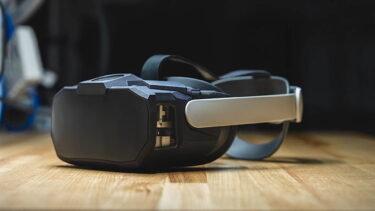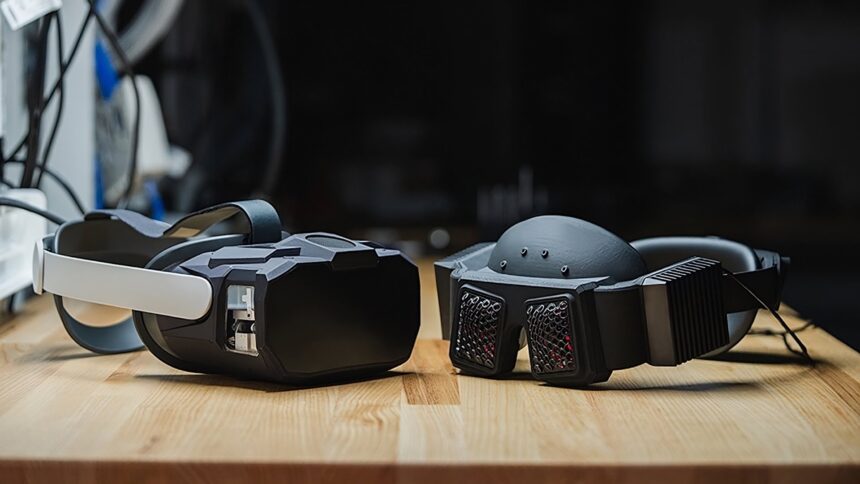Meta's new headset prototype to offer unprecedented visual fidelity

Meta introduces two new VR prototypes. The first, called Butterscotch Varifocal, combines retinal resolution with varifocal optics.
The Siggraph computer graphics conference opens Sunday. Meta will exhibit two new research prototypes in Los Angeles: Butterscotch Varifocal and Flamera.
Last summer, Meta already introduced three VR prototypes in more detail, Butterscotch, Starburst and Holocake 2.
All of these prototypes have one thing in common: they are proofs of concept, designed to show what some aspect of VR technology can do when pushed to the extreme, whether it be retina resolution, ultra-high display brightness, or compact form factor. It's an approach Meta calls "Demo or Die".

The new headset prototypes Butterscotch Varifocal and Flamera that will be shown at Siggraph 2023. | Image: Meta
Whether the prototypes can be turned into a practical and affordable product is of secondary importance. Meta emphasizes that the technologies tested may never find their way into end products. This is also true for Butterscotch Varifocal and Flamera.
Content
Butterscotch Varifocal: the back story
Butterscotch Varifocal combines the varifocal technology of the older Half-Dome prototypes (2018-2019) with Butterscotch's retina display (2022).
Half-Dome 1-3 were designed with the goal of building a compact VR headset with varifocal capabilities, that allows a natural focusing of virtual objects at close range, a hard to solve technical problem also known as vergence-accommodation conflict.
A headset with a varifocal display allows the eyes to focus in VR the same way they do in natural environments, eliminating eye pain and other discomfort that can occur when using VR technology.
The 2022 Butterscotch prototype had a different purpose: to demonstrate how a display with a resolution approaching the capabilities of the human eye would look like. The prototype achieves a pixel density of 55 PPD. For comparison: Meta Quest 2 achieves only 20 PPD.
The Butterscotch Varifocal is the first Meta prototype that combines the two technologies in one device. The prototype offers the same varifocal technology known from Half-Dome 1 and 2, as well as a display pixel density of approximately 60 PPD.
These are the shortcomings of the prototype
It should be noted that Butterscotch Varifocal is a PC VR headset, not a standalone device like Meta Quest. Also, the field of view is only 50 degrees, half that of Meta Quest 2. Another drawback is that the prototype is larger and contains mechanical parts that make it more susceptible to failure and wear.
With Half-Dome 3, Meta designed a varifocal headset with electrical rather than mechanical shift of focus and a small form factor. However, the technology presented problems with light transmission and image quality, so Meta discarded it for Butterscotch Varifocal at the expense of weight and size.
However, this does not mean that Meta has abandoned work on a solid-state varifocal solution. Work continues on the half-dome prototypes, says Display Systems Research Director Douglas Lanman. With Butterscotch Varifocal, the focus is solely on showcasing the experience of retinal resolution in VR, which is why they haven't named the prototype Half-Dome 4.
The software has also made great strides
The end result is said to be nothing short of extraordinary. “With Butterscotch Varifocal, we can see things in VR in a similar resolution and quality compared to what we see in the physical world,” says Optical Scientist Yang Zhao, “which opens up doors to many new possibilities of building amazing experiences in VR.”
According to Meta, it's not just the hardware that has evolved. The varifocal software has become an integral part of the rendering pipeline and is much better integrated with rest of Meta's VR platforms.
"This tighter integration also means that we support many more games and applications today, compared to our early varifocal headsets that would often use more simplistic or custom demo content," says Research Scientist Olivier Mercier. "Our understanding of distortion correction, eye tracking, rendering, and latency have all been refined to create a high-quality experience that can use our best varifocal hardware to its maximum capabilities."
Note: Links to online stores in articles can be so-called affiliate links. If you buy through this link, MIXED receives a commission from the provider. For you the price does not change.